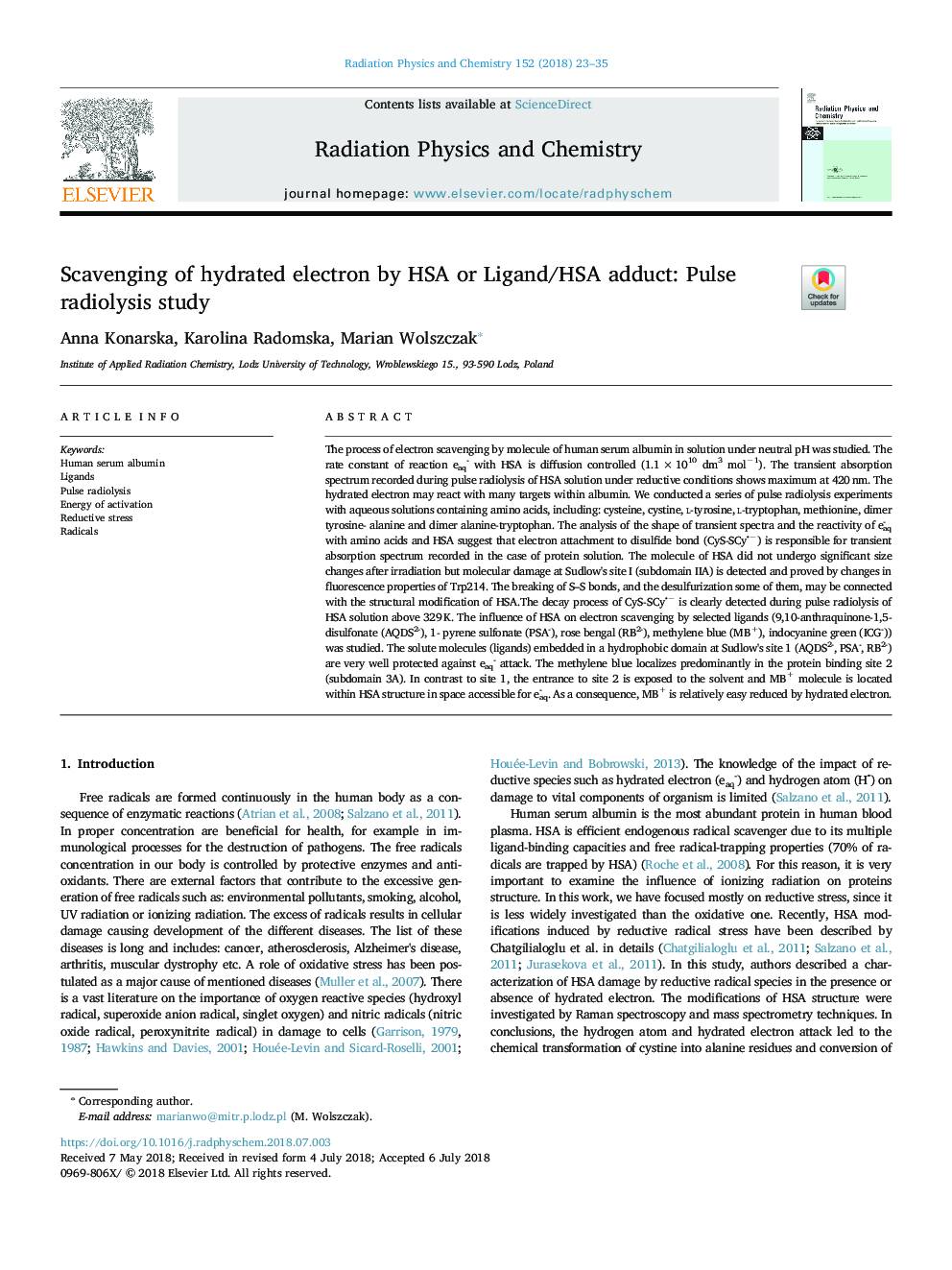| Article ID | Journal | Published Year | Pages | File Type |
|---|---|---|---|---|
| 8251089 | Radiation Physics and Chemistry | 2018 | 13 Pages |
Abstract
The process of electron scavenging by molecule of human serum albumin in solution under neutral pH was studied. The rate constant of reaction eaq- with HSA is diffusion controlled (1.1â¯Ãâ¯1010 dm3 molâ1). The transient absorption spectrum recorded during pulse radiolysis of HSA solution under reductive conditions shows maximum at 420â¯nm. The hydrated electron may react with many targets within albumin. We conducted a series of pulse radiolysis experiments with aqueous solutions containing amino acids, including: cysteine, cystine, L-tyrosine, L-tryptophan, methionine, dimer tyrosine- alanine and dimer alanine-tryptophan. The analysis of the shape of transient spectra and the reactivity of e-aq with amino acids and HSA suggest that electron attachment to disulfide bond (CyS-SCy
- â) is responsible for transient absorption spectrum recorded in the case of protein solution. The molecule of HSA did not undergo significant size changes after irradiation but molecular damage at Sudlow's site I (subdomain IIA) is detected and proved by changes in fluorescence properties of Trp214. The breaking of S-S bonds, and the desulfurization some of them, may be connected with the structural modification of HSA.The decay process of CyS-SCy
- â is clearly detected during pulse radiolysis of HSA solution above 329â¯K. The influence of HSA on electron scavenging by selected ligands (9,10-anthraquinone-1,5-disulfonate (AQDS2-), 1- pyrene sulfonate (PSA-), rose bengal (RB2-), methylene blue (MB+), indocyanine green (ICG-)) was studied. The solute molecules (ligands) embedded in a hydrophobic domain at Sudlow's site 1 (AQDS2-, PSA-, RB2-) are very well protected against eaq- attack. The methylene blue localizes predominantly in the protein binding site 2 (subdomain 3A). In contrast to site 1, the entrance to site 2 is exposed to the solvent and MB+ molecule is located within HSA structure in space accessible for e-aq. As a consequence, MB+ is relatively easy reduced by hydrated electron.
- â) is responsible for transient absorption spectrum recorded in the case of protein solution. The molecule of HSA did not undergo significant size changes after irradiation but molecular damage at Sudlow's site I (subdomain IIA) is detected and proved by changes in fluorescence properties of Trp214. The breaking of S-S bonds, and the desulfurization some of them, may be connected with the structural modification of HSA.The decay process of CyS-SCy
- â is clearly detected during pulse radiolysis of HSA solution above 329â¯K. The influence of HSA on electron scavenging by selected ligands (9,10-anthraquinone-1,5-disulfonate (AQDS2-), 1- pyrene sulfonate (PSA-), rose bengal (RB2-), methylene blue (MB+), indocyanine green (ICG-)) was studied. The solute molecules (ligands) embedded in a hydrophobic domain at Sudlow's site 1 (AQDS2-, PSA-, RB2-) are very well protected against eaq- attack. The methylene blue localizes predominantly in the protein binding site 2 (subdomain 3A). In contrast to site 1, the entrance to site 2 is exposed to the solvent and MB+ molecule is located within HSA structure in space accessible for e-aq. As a consequence, MB+ is relatively easy reduced by hydrated electron.
Related Topics
Physical Sciences and Engineering
Physics and Astronomy
Radiation
Authors
Anna Konarska, Karolina Radomska, Marian Wolszczak,
